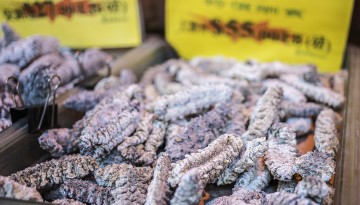Endangered Sea Cucumbers Spotted in NYC Food Markets Raise Conservation Concerns
After surveying food market retailers in three New York City Chinatown districts, Cornell researchers have found genetic evidence that some endangered species of sea cucumbers – considered a pricey but nutritious dried delicacy – are being sold to consumers.
The researchers collected 103 samples of dried sea cucumbers from retail food shops. By using mitochondrial DNA testing, they successfully identified 74 examples of sea cucumbers. Eight were classified as brown sea cucumber, Isostichopus fuscus – which is threatened and found on the International Union for the Conservation of Nature (IUCN) Red List due to overharvesting.
“We were able to genetically identify that the endangered species of brown sea cucumbers – around 10% of the sampled retail market – was being sold,” said lead author Jesse Rodenbiker, a former postdoctoral researcher in the Department of Natural Resources and the Environment, in the College of Agriculture and Life Sciences, and now an assistant teaching professor in geography at Rutgers University. “It suggests that the kind of level at which sea cucumbers are available on the market may pose a threat for biodiversity loss.”
The research, “Advancing One Health in Urban Seafood Markets: A Genetic and Social Analysis of Dried Sea Cucumber in Three New York City Chinatowns,” was published April 25 in the journal Sustainability.
Rodenbiker and undergraduate students conducted retailer surveys and collected sea cucumber samples, and then brought samples to the laboratory of co-author Nina Overgaard Therkildsen, associate professor in the Department of Natural Resources and the Environment (CALS). Her laboratory conducts research in conservation genomics and molecular ecology in the ocean environment.
There are 1,716 known species of sea cucumbers, which are marine invertebrates that behave like vacuum cleaners roaming the sea floor worldwide, Rodenbiker said. Of these species, 16 are listed as either vulnerable or endangered.
In 2021 and 2022, Cornell students Kelly Su ’24 and Erica Ruan ’24 (who speak Mandarin and Cantonese) conducted semi-structured interviews with merchants in Chinese neighborhoods in Manhattan, Brooklyn and Queens. Rodenbiker purchased dried sea cucumbers, usually labeled by originating geographic region – Japan, Mexico and South America. In the interviews, the retailers acknowledged limited understanding of where the sea cucumbers originated.
Consumers are willing to pay premium prices for sea cucumbers, which are added to soups. During the survey period, the price for sea cucumber was between $169 and $229 per pound.
“Although the resolution on this pilot study was a bit coarse, we show that the sourcing for sea cucumbers is quite different among shops and different neighborhoods,” said Therkildsen, who is also a faculty fellow at the Cornell Atkinson Center for Sustainability. “By no means was this an exhaustive survey, but it suggests differing sourcing patterns.”
Therkildsen recognized that even brown sea cucumbers can be harvested legally in certain parts of the world, but there are no genetic tools yet to trace species origination. “To conduct any enforcement at merchant food shops, we need tools that can assign a specimen back to a region from where they are protected and we are currently working on developing such tools,” she said.
Rodenbiker indicated a need for more robust point-of-origination training for the retailers, improved labeling in the markets and public outreach to advance the concept of One Health – an idea that humans, animals and the environment are all connected – in urban seafood markets.
“Given that brown sea cucumbers are abundant on the market,” he said, “there is a need for developing genetic markers that can trace geographic origin to determine if a species was legally harvested.”
Funding for this research was provided by Cornell Atkinson.

